Henley-on-Thames to Tilehurst
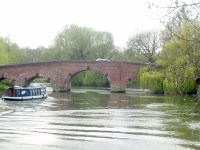
Henley-on-Thames to Tilehurst |  |
| Upstream: Tilehurst to Cholsey | Back to Main Page | Downstream: Bourne End to Henley-on-Thames |
Introduction
The Thames path quickly becomes rural from Henley-on-Thames into the lovely village of Shiplake where the path briefly leaves the river. From Shiplake there is several miles of peaceful walking before arriving at the attractive village of Sonning where the Thames path switches banks on its way to the busy town of Reading, where the Thames joins the Kennet and Avon Canal. Passing through the town the Thames then runs parallel to the Great Western Railway on the approach to Tilehurst, the end of this walk.
Getting to the Start
There is a station in Henley-on-Thames, which is on a branch line from Twyford. This is served by hourly trains (7 days a week) from Twyford, from where there are connections to Reading, Didcot, Oxford and London Paddington. All trains to Henley-on-Thames are operated by First Great Western Link. Be careful if using it though, when I travelled the train was incorrectly advertised as a train to London Paddington at Twyford causing confusion.
Arriva bus services 328 and 329 run every 30 minutes (hourly on Sundays) from High Wycombe, Marlow, Medmenham and Reading to Henley. Thames Travel service 139 operates hourly (Monday - Saturday, once every 2 hours on Sunday) to Henley from Wallingford. Thames Travel services 140, 142 and 145 run approximately once every 2 hours, Monday - Saturday from Reading, Woodcote and Sonning to Henley.
The Walk
From Henley Bridge you need to cross the river into the town, onto the north bank of the river (or in fact the west as it is here). Once over the bridge, turn left into Thames Side where the Thames Path continues. Soon the path opens out into a (popular) recreation ground.
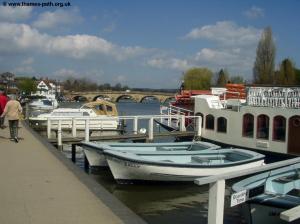 |
| Henley-on-Thames |
Continue along this busy part of the path, with fields to the right until you get to Marsh Lock. The Thames path crosses onto a bridge round the lock here, however when I walked this part of the Thames Path it was diverted away from the river due to works on the path over the lock. This diversion has ended now however.
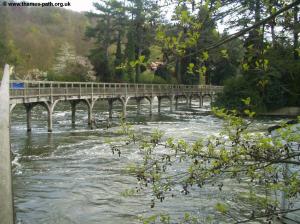 |
| The path over Marsh Lock |
Beyond Marsh Lock the Thames takes on a more rural character again, with open meadows to the right. Soon however the Thames Path leaves the banks of the river to head into Shiplake. The path is well signed and takes you down a tree-lined road past some impressively large houses, one of which even has it's own miniature railway. This is Bolney Road and you follow it until you turn off right to walk next to the railway line from Henley. The path follows the line (ignore the pedestrian crossing) until the level crossing, where you cross the line. Once over the railway line, turn left into Mill Road. Follow this road for a while but where another road appears on the left (to Andrew Duncan House) turn down here then quickly right again to return to the riverside at Shiplake Lock.
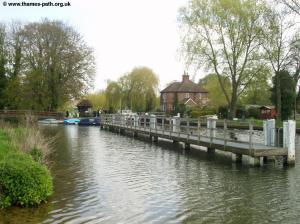 |
| Shiplake Lock |
Once back on the river it's peaceful walking through a rural scene for a couple of miles. This part of the Thames is very peaceful and you are only likely to be disturbed by the occasional passing boat except perhaps when passing Shiplake College, with it's pretty boat house. Across the river the other bank is several large islands, now connected by bridges over St Patrick's stream.
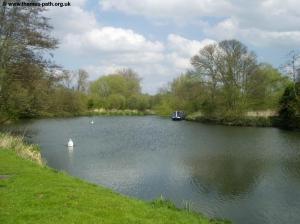 |
| Near Hallsmead Ait |
Soon you'll round the corner and see the attractive bridge at Sonning ahead. Here you first cross a small footbridge taking you onto Sonning Bridge which you then also cross into the village.
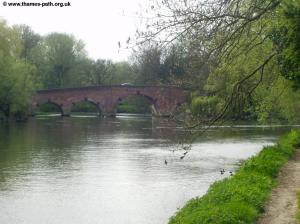 |
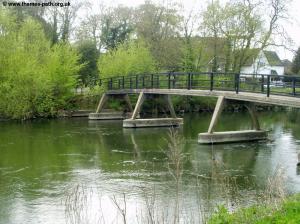 |
| Sonning Bridge | The footbridge next to Sonning Bridge |
Sonning is a beautiful river-side village that is well worth spending some time to look around.
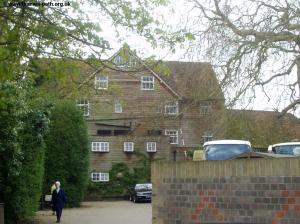 |
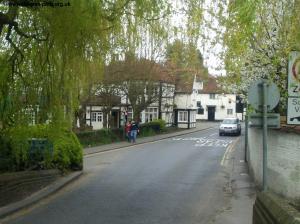 |
| Sonning Mill | Sonning Village |
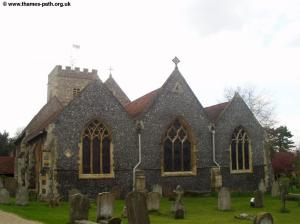 |
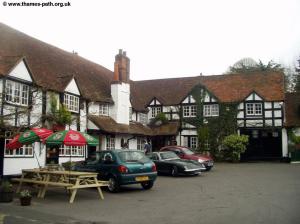 |
| Sonning Church | Sonning Village |
The Thames path continues on the south side of the bridge.
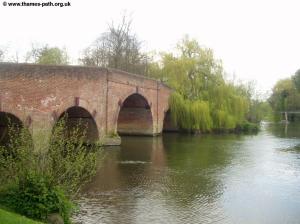 |
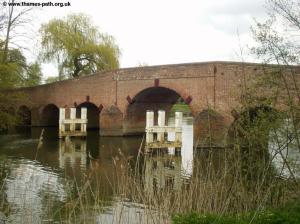 |
| Sonning Bridge | Sonning Bridge |
Shortly after leaving Sonning you come to Sonning Lock, a well kept lock, similar to many others on the Thames.
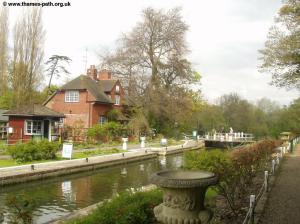 |
| Sonning Lock |
Almost immediately after leaving Sonning Lock you are passing next to the grounds of Reading Blue Coat School, which also has a small boathouse. Beyond the school you have meadows again, although some of the large office buildings aren't far from the path to the left, a reminder that the Thames is now almost in Reading. It isn't long before the busy Great Western Railway line runs parallel to the Thames and soon you get to the start of the Kennet and Avon Canal, the towpath of which will take you into Bath and on to Bristol. The crossing of the canal is a little unusual in that a pedestrian footbridge has been constructed in front of the railway bridge over the canal.
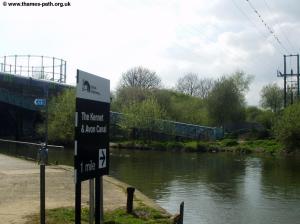 |
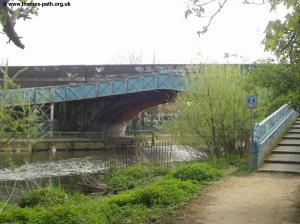 |
| The start of the Kennet and Avon Canal | The bridge over the canal |
Beyond the Canal the Thames Path pases a large Tesco store on the left but soon this gives way to a pleasant meadow once more, which is a popular spot. Soon Caversham Lock is ahead, a surprisingly rural scene considering the Thames is now a short distance from Reading, a very large town. Beyond the Lock is Reading Bridge.
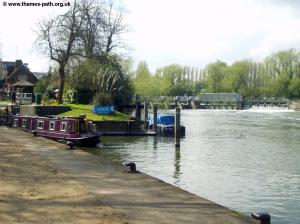 |
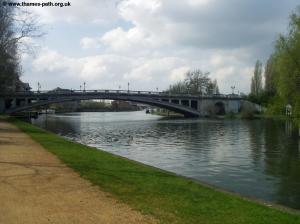 |
| Caversham Lock | Reading Bridge |
At Reading Bridge you can turn left for Reading Station and the town centre. Reading is a thriving town, with many large office buildings and large river-side apartments. The town centre is a popular shopping centre with many well-known names. The large indoor centre (The Oracle Centre) backs on to the Kennet and Avon Canal, with a range of cafes and pubs along the canal side. Although perhaps not the most attractive town centre, it does seem to have a lot going for it. The town is also well connected, with the nearby station having direct trains to places as far afield as Aberdeen, Penzance, Hereford and Swansea as well as frequent trains to London Paddington, less than 30 minutes away and Birmingham, a little over 90 minutes away. Reading would be a good place to finish, but I decided to continue on to Tilehurst.
Pass under Reading Bridge, a fairly attractive bridge, and you'll find modern flats and offices on the banks of the Thames. Whether you like them or not, it's good to see modern architecture has developed beyond building ugly concrete blocks.
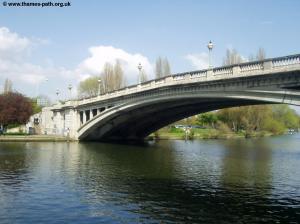 |
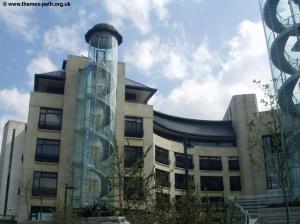 |
| Reading Bridge | A modern building by Reading Bridge |
You pass Fry's Island to the right, where you can see Caversham Bridge ahead. Beyond the bridge, the path becomes relatively rural in character again, surprising considering how close it is to the centre of Reading.
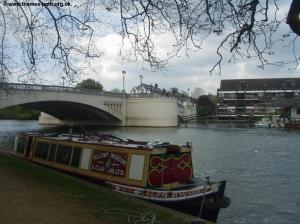 |
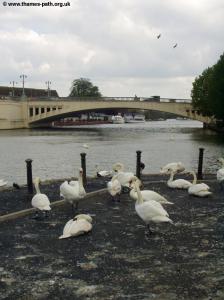 |
| Caversham Bridge | Looking back to Caversham Bridge |
The path continues next to the leisure centre briefly, but once past that the area to the left is fairly open. To the right you can see the attractive church at Caversham.
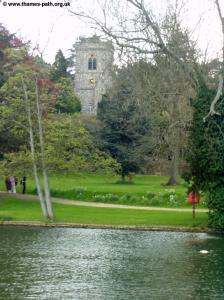 |
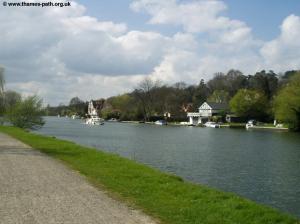 |
| Caversham Church across the river | The Thames near Reading |
Beyond the church on the north bank, there are a few houses, but even these soon give way to fields again. On the left however you'll soon be walking next to the wall that carries the Great Western Railway, where trains travel at very high-speed. This continues all the way to Tilehurst.
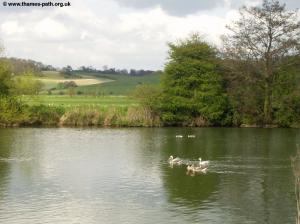 |
| The Thames near Tilehurst |
Officially, the Thames Path runs next to the railway line beyond Tilehurst station, crossing the railway line on a footbridge further up. However I found that the path was diverted via a temporary staircase right onto the platform at Tilehurst station, making getting back convenient.
Getting Back
Since when I walked this part of the Thames Path, the path was diverted onto the platform of Tilehurst station, this seems the most convenient way to get back. If this diversion has since been removed, continue on the Thames path until it is then signed up a bridge to cross the railway line, emerging onto a main road, where you turn left and continue on this road until you reach the station. Tilehurst station has trains every 30 minutes Monday - Saturday and every hour on Sundays, all operated by First Great Western Link. Tilehurst is on the London Paddington and Reading to Oxford line. Trains take 5 minutes to get to Reading, and almost all continue on to London Paddington (although it can be quicker to change at Reading, from where there are also trains to London Waterloo). For Henley-on-Thames take a train towards Reading and London, most trains from Tilehurst also call at Twyford, where you change for the train to Henley. Connections are available at Reading to much of the country especially to the South West and South Coast, as well as Gatwick Airport and London Waterloo. By taking a train towards Oxford from Tilehurst you can change at Didcot Parkway for trains towards Swindon, Bristol, Cardiff and Swansea. If you're heading north towards Birmingham and beyond, change at Oxford for frequent trains to Leamington and Birmingham.
Links
The following web sites provide information on the area.
Every effort is made to ensure the accuracy of information on this site, but liability will not be assumed in the event of any inaccuracies. Use of the information on this site is at your own risk. If you find any errors, please use the link below. The text and photographs on this web site are all Copyright © and may not be reproduced without prior permission